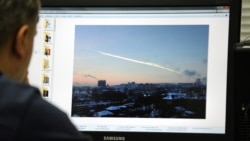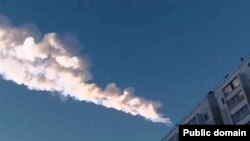The U.S. National Oceanic and Atmospheric Administration (NOAA) has published a GIF image that shows -- from space -- the vapor trail from the meteor hitting Earth's atmosphere as it plummeted toward Chelyabinsk. It's made up of eight images taken at 15-minute intervals.
In seemingly but not actually related news, scientists say the 46-meter-across asteroid dubbed 2012 DA14 has safely bypassed Earth at a distance of around 28,000 kilometers in the closest recorded flight of a space object of that size. The smaller meteor that hurtled into Chelyabinsk was traveling in the opposite direction of 2012 DA14, so scientists dismissed the notion that the two events might be related.
"This type of event, in general, is very extraordinary -- probably [occurring] once per 30 or 40 years -- and it can happen anywhere, in any part of the world. The largest recorded explosion of a space object was the famous Tunguska event in 1908. That was 5,000 kilometers east of Chelyabinsk. It's very, very rare."
Interview: Meteor Expert Says Russian Strike Was 'Extraordinary'
Marina Ivanova is a senior scientist in the Laboratory of Meteoritics at Moscow's Vernadsky Institute.
Interview: Meteor Expert Says Russian Strike Was 'Extraordinary'
Marina Ivanova is a senior scientist in the Laboratory of Meteoritics at Moscow's Vernadsky Institute.





